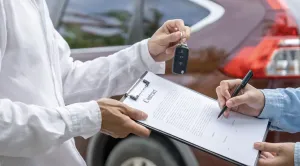Clear paperwork can help prove mortgage fraud. Bank records can show strange patterns in deposits and wrong income reports. Work records help catch fake pay stubs and W-2s. House value reports might reveal wrong prices or changed pictures. Emails and computer records often show when bad things happened. Tax forms, house ownership papers, and loan requests work together to show the full picture of mortgage cheating.
Key Takeaways
- Inconsistencies between reported income on loan applications and actual bank statements reveal fraudulent income claims.
- Altered property appraisal reports showing manipulated photographs, square footage, or comparable sales data indicate fraud.
- Forged or varying signatures across different mortgage documents suggest unauthorized document manipulation.
- Email communications and digital metadata showing document alterations or suspicious collaborations between parties involved.
- Mismatched employment documentation, including falsified W-2 forms, pay stubs, and employer verification records.
Key Red Flags in Loan Applications
When checking mortgage loan paperwork, money experts need to watch for signs that something might be wrong.
During the review process, big warning signs include income that doesn’t match work history, big money deposits right before applying, and signatures that look different on various forms.
Careful checking of the person applying often finds problems with Social Security numbers, hidden properties or loans, and questionable bank records.
Other red flags include home values that seem too high, fake buyers, and changed tax documents.
If these signs appear, staff must report them quickly to stop false loans from being approved.
Bank Statement Analysis and Verification
Bank statements need careful checking to spot mortgage fraud. Reviewers look at deposits to find odd patterns, strange transactions, and big unexplained amounts that might show fake income.
Regular checks help find differences between what people say they earn and what actually goes into their accounts.
Important checking steps include making sure dates match when statements were turned in, looking at how deposits follow each other, and checking if statements look like real bank forms.
Reviewers also look for signs that documents were changed online, check how clear certain parts look, and make sure bank routing numbers match real bank records to catch clever attempts at changing documents.
Employment and Income Documentation
Checking job and income paperwork is key to stopping mortgage fraud. Fraud teams look at job proof in different ways to find lies and fake documents. They compare W-2s, paychecks, and tax forms to spot problems that might show fraud.
| Document Type | How It’s Checked |
| W-2 Forms | IRS Record Check |
| Pay Stubs | Call to Employer |
| Tax Returns | Compare with IRS |
| Bank Deposits | Check Against Claimed Income |
All income papers must match each other when reviewed carefully. Warning signs include dates that don’t line up, odd payment patterns, and company details that can’t be found in state business lists. Further checks may include talking to employers and looking at public records to make sure the business is real.
Property Appraisal Records and Reports
A critical examination of property appraisal records reveals various methods used to artificially inflate property values, including manipulated photographs, altered property condition assessments, and fabricated renovation claims.
The comparison between original and modified appraisal reports often exposes discrepancies in square footage calculations, property features, and market conditions that serve to misrepresent the true value.
Professional appraisers investigating mortgage fraud scrutinize comparable sales manipulation through the selective use of dissimilar properties, outdated sales data, and undisclosed market adjustments that distort the final valuation.
Fraudulent Value Inflating Methods
Property value fraud schemes cause major damage when people lie about how much homes are worth, leading to big losses for banks and lenders. People who commit this fraud often change sales records of nearby homes or hide problems with the property. When looking into these cases, experts check multiple property reports to spot differences.
| Fraud Type | Signs to Watch | How Bad It Is |
| Changed Sales Info | Fake Price Data | Bad |
| Hidden Problems | Covered-Up Issues | Very Bad |
| Wrong Size Claims | Papers Don’t Match | Worst |
| Made-Up Features | Things Not There | Bad |
The worst cases happen when several people work together to make fake property values. They do this by setting up fake sales and creating false papers about home improvements. Finding all the proof takes careful detective work.
Original Vs Modified Reports
Property appraisals come in two forms – the first version and later changed versions. This creates a paper trail that helps investigators spot mortgage fraud.
When looking at original documents, red flags often appear by comparing first reports with changed ones, showing someone made unauthorized changes to property information, similar home sales data, or final value numbers.
Problems arise when people tamper with digital files by changing dates or making completely fake versions of appraisal papers.
To catch this fraud, experts check file data, digital signatures, and saved copies. This helps them confirm when documents were really created and find fake changes meant to hide inflated home values or false property details.
Comparable Sales Manipulation
Real estate appraisers need to use recent home sales data to find fair property values, but dishonest people often twist this data to commit mortgage fraud.
These scammers pick and choose sales information to make properties seem worth more than they really are. They might use sales from better neighborhoods, leave out nearby sales showing lower prices, or include sales between related parties that don’t reflect true market prices.
These tricks show up when looking at different property reports over time. Fraud investigators find this cheating by checking things like house features, neighborhood quality, and when sales happened.
This helps them spot cases where someone picked only certain sales to make values look higher than they should be.
Tax Return Discrepancies and Audits
Tax paperwork in mortgage applications needs careful checking when numbers don’t match up.
Lenders look for warning signs like differences between tax returns shown to them versus IRS copies, sudden jumps in income, and work history that doesn’t line up.
Those who check these documents use special steps to catch people trying to cheat on taxes through fake pay stubs, made-up business earnings, or wrong tax write-offs.
They look at several years of tax returns, check if employers are real, and review bank records to spot any tricks meant to get bigger home loans or better deals.
Title History and Ownership Records
Looking at who owned a property over time helps catch mortgage fraud, much like checking tax papers does.
Title searches show important clues about fake deals through how properties change hands.
Signs that something might be wrong include:
- Property changing hands quickly between people who know each other
- Missing or unclear information about who owned the property before
- Dates and prices that don’t match up on different papers
- Signatures or official stamps that look wrong on ownership papers
These records help investigators tell the difference between normal property sales and suspicious deals that need more checking for possible fraud.
Digital Communication Evidence and Paper Trails
The digital evidence trail in mortgage fraud cases often centers on email communications between involved parties, including loan officers, borrowers, and real estate professionals.
Investigators analyze email chains chronologically to identify inconsistencies, altered documents, and potentially fraudulent exchanges that deviate from standard mortgage protocols.
Digital document records require thorough examination for signs of manipulation, such as metadata inconsistencies, altered timestamps, or unauthorized modifications to loan applications and supporting materials.
Email Chains Between Parties
Email messages between people involved in mortgage deals can help uncover fraud by showing who talked to whom and when. These emails create a timeline of messages between borrowers, banks, brokers, and others, making it easier to spot wrongdoing. The back-and-forth emails show how people worked together and what they planned to do.
- Messages with dates that show changes made to loan papers
- Emails sharing fake income papers between people working together
- Talk about house prices and lies told about them
- Messages telling others how to change documents
These email trails often uncover fraud schemes by showing differences in information, changed paperwork, and how people worked together to trick banks or home buyers by changing mortgage documents on purpose.
Falsified Digital Document Records
Digital fraud leaves clear traces when people try to fake documents and records.
Wrong dates, changed file details, and fake signatures create unusual patterns that show up in computer systems. These problems often come to light when experts check loan papers, property reports, and money records.
By looking at computer logs, saved files, and edit histories, investigators can piece together when changes were made.
When documents have fake dates, unwanted changes, or copied signatures, these digital clues help prove the crime. Since electronic records last forever, it’s getting harder for cheaters to hide when they change documents.
Frequently Asked Questions
What Is the Statute of Limitations for Reporting Suspected Mortgage Fraud?
The time limit to report mortgage fraud depends on where you live. For federal cases, you have up to 10 years to report the crime. At the state level, you usually have between 3 to 6 years to report fraud after you find out about it.
Can Mortgage Fraud Be Detected After the Loan Has Been Fully Paid?
Yes, signs of mortgage fraud can still be found after a loan is paid off by looking closely at loan papers, payment records, and how the loan was handled. Companies that look for fraud often find problems with old loans by searching through past records and checking if rules were broken.
How Do Whistleblowers Report Mortgage Fraud Anonymously?
You can report mortgage wrongdoing without giving your name through tip lines at HUD, the FBI website, or FinCEN’s safe reporting tools. Many state watchdog groups also let you tell them about mortgage cheating in private.
Are Digital Signatures as Legally Binding as Handwritten Ones in Mortgage Documents?
Digital signatures are just as valid as pen-and-paper signatures on mortgage papers, thanks to laws like ESIGN and UETA. Lenders and borrowers can rely on these electronic signatures in every U.S. state when signing mortgage documents.
What Percentage of Mortgage Fraud Cases Result in Criminal Prosecution?
Studies show that out of every 100 mortgage fraud cases reported, only about 10 to 15 end up going to criminal court. How these cases are handled differs from place to place, and depends on how strong the proof is in each case.
Conclusion
Our experts at Ace California Law know that proving mortgage fraud requires looking at many types of documents. We review bank statements, pay stubs, work history checks, tax filings, and property value reports to spot lies and tricks. We also check emails, text messages, and other communications that might show dishonesty. Looking at property titles and ownership papers helps us uncover fake deals. To build a strong legal case, we carefully examine every document for signs of tampering and verify all information provided on loan applications.







